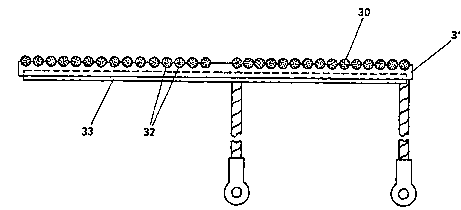Une partie des informations de ce site Web a été fournie par des sources externes. Le gouvernement du Canada n'assume aucune responsabilité concernant la précision, l'actualité ou la fiabilité des informations fournies par les sources externes. Les utilisateurs qui désirent employer cette information devraient consulter directement la source des informations. Le contenu fourni par les sources externes n'est pas assujetti aux exigences sur les langues officielles, la protection des renseignements personnels et l'accessibilité.
L'apparition de différences dans le texte et l'image des Revendications et de l'Abrégé dépend du moment auquel le document est publié. Les textes des Revendications et de l'Abrégé sont affichés :
| (12) Demande de brevet: | (11) CA 2183061 |
|---|---|
| (54) Titre français: | ELEMENT CHAUFFANT PAR INDUCTION |
| (54) Titre anglais: | INDUCTION HEATING ELEMENT |
| Statut: | Réputée abandonnée et au-delà du délai pour le rétablissement - en attente de la réponse à l’avis de communication rejetée |
| (51) Classification internationale des brevets (CIB): |
|
|---|---|
| (72) Inventeurs : |
|
| (73) Titulaires : |
|
| (71) Demandeurs : |
|
| (74) Agent: | GOWLING WLG (CANADA) LLP |
| (74) Co-agent: | |
| (45) Délivré: | |
| (86) Date de dépôt PCT: | 1995-02-09 |
| (87) Mise à la disponibilité du public: | 1995-08-17 |
| Requête d'examen: | 2002-01-10 |
| Licence disponible: | S.O. |
| Cédé au domaine public: | S.O. |
| (25) Langue des documents déposés: | Anglais |
| Traité de coopération en matière de brevets (PCT): | Oui |
|---|---|
| (86) Numéro de la demande PCT: | PCT/GB1995/000258 |
| (87) Numéro de publication internationale PCT: | WO 1995022239 |
| (85) Entrée nationale: | 1996-08-09 |
| (30) Données de priorité de la demande: | ||||||
|---|---|---|---|---|---|---|
|
Un élément chauffant pour une plaque de cuisson à induction comprend un serpentin plat enroulé en spirale (30) consistant en une pluralité de conducteurs parallèles et isolés. Le serpentin est enroulé dans une rainure (32) en forme de spirale disposé à la surface supérieure d'une plaque de support en plastique (31). Une base circulaire (33) constituée en un matériau à haute perméabilité magnétique est disposée sur la face inférieure de la plaque de support (31). La base (31) focalise le champ magnétique généré par le serpentin dans une zone de chauffe au-dessus du serpentin, et empêche également toute partie métallique environnante de chauffer de manière indue.
A heating element for an inductive cooking hob comprises a flat spirally-wound coil (30) consisting of a plurality of parallel insulated
conductors. The coil is wound in a spirally-extending groove (32) disposed on the upper surface of a plastics former (31). A circular base
(33) of highly magnetically permeable material is disposed on the underside of the former (31). The base (31) focuses the magnetic field
generated by the coil into a heating area above the coil, and also prevents any surrounding metalwork from inadvertently being heated.
Note : Les revendications sont présentées dans la langue officielle dans laquelle elles ont été soumises.
Note : Les descriptions sont présentées dans la langue officielle dans laquelle elles ont été soumises.

2024-08-01 : Dans le cadre de la transition vers les Brevets de nouvelle génération (BNG), la base de données sur les brevets canadiens (BDBC) contient désormais un Historique d'événement plus détaillé, qui reproduit le Journal des événements de notre nouvelle solution interne.
Veuillez noter que les événements débutant par « Inactive : » se réfèrent à des événements qui ne sont plus utilisés dans notre nouvelle solution interne.
Pour une meilleure compréhension de l'état de la demande ou brevet qui figure sur cette page, la rubrique Mise en garde , et les descriptions de Brevet , Historique d'événement , Taxes périodiques et Historique des paiements devraient être consultées.
| Description | Date |
|---|---|
| Inactive : CIB de MCD | 2006-03-12 |
| Demande non rétablie avant l'échéance | 2004-02-09 |
| Le délai pour l'annulation est expiré | 2004-02-09 |
| Réputée abandonnée - omission de répondre à un avis sur les taxes pour le maintien en état | 2003-02-10 |
| Lettre envoyée | 2002-03-14 |
| Inactive : Dem. traitée sur TS dès date d'ent. journal | 2002-03-14 |
| Inactive : Renseign. sur l'état - Complets dès date d'ent. journ. | 2002-03-14 |
| Exigences pour une requête d'examen - jugée conforme | 2002-01-10 |
| Toutes les exigences pour l'examen - jugée conforme | 2002-01-10 |
| Demande publiée (accessible au public) | 1995-08-17 |
| Date d'abandonnement | Raison | Date de rétablissement |
|---|---|---|
| 2003-02-10 |
Le dernier paiement a été reçu le 2002-01-04
Avis : Si le paiement en totalité n'a pas été reçu au plus tard à la date indiquée, une taxe supplémentaire peut être imposée, soit une des taxes suivantes :
Veuillez vous référer à la page web des taxes sur les brevets de l'OPIC pour voir tous les montants actuels des taxes.
| Type de taxes | Anniversaire | Échéance | Date payée |
|---|---|---|---|
| TM (demande, 3e anniv.) - petite | 03 | 1998-02-09 | 1998-01-16 |
| TM (demande, 4e anniv.) - petite | 04 | 1999-02-09 | 1999-02-03 |
| TM (demande, 5e anniv.) - petite | 05 | 2000-02-09 | 2000-01-06 |
| TM (demande, 6e anniv.) - petite | 06 | 2001-02-09 | 2001-01-11 |
| TM (demande, 7e anniv.) - petite | 07 | 2002-02-11 | 2002-01-04 |
| Requête d'examen - petite | 2002-01-10 |
Les titulaires actuels et antérieures au dossier sont affichés en ordre alphabétique.
| Titulaires actuels au dossier |
|---|
| INDUCED ENERGY LIMITED |
| Titulaires antérieures au dossier |
|---|
| MALCOLM ROBERT SNOWBALL |